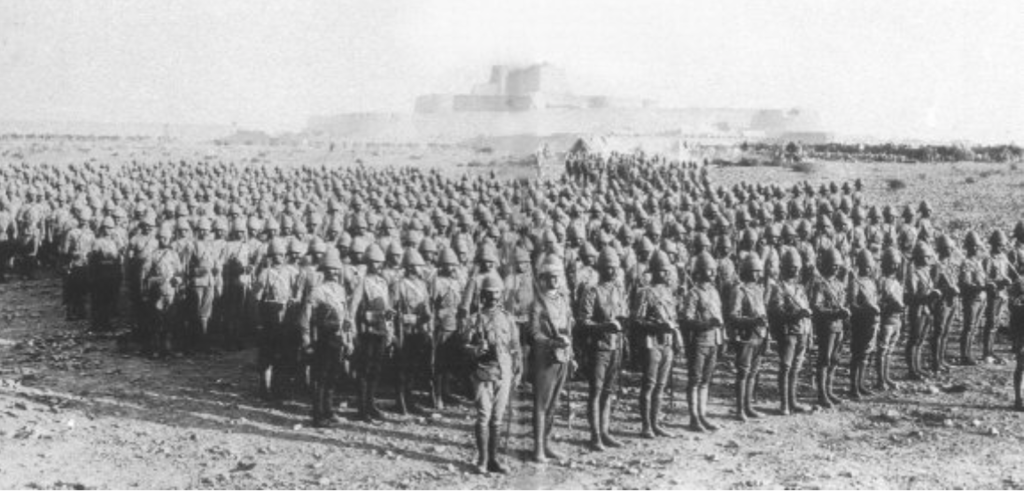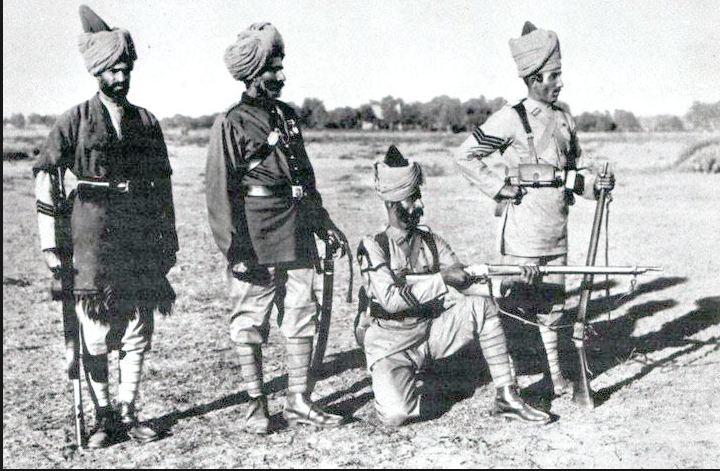I was wrong on the puttees....1897 photo of British Army troops mobilized for the "Mad Mullah"campaigns of 1897-98 in the Pashtun areas of Bajur, Kyber, etc. Churchill wrote a great book about the Bajur campaign
The Story of the Malakand Field Force.. (for what it's worth, I've driven over that pass (going north from the Peshawar plains over into the Swat Valley)....and flown over it in helicopters - how anyone could climb those Knifed-edged ridges under fire is beyond me).

.
Allegedly a Photo of Guides troops during the relief of the Chitral fort in 1895..I doubt that - they had to go over the Shandur Pass, a 14,000' Himalayan pass from Gilgit to Chitral in dead of winter (unless they were part of the second prong which forced the Malakand Pass - coming up from Peshawar). (Recommend the book "
Where Three Empires Meet" if you're curious). They're holding brand new Martini-Henry's. After the mutiny, Brits always made sure Indian troops were one generation behind in rifles...By this time Lee-Enfield (Long Lees) were being issued to British troops.

This from Wikipedia:
The puttee was first adopted as part of the service uniform of foot and mounted soldiers serving in British India during the second half of the nineteenth century. In its original form the puttee comprised long strips of cloth worn as a tribal legging in the Himalayas. The British Indian Army found this garment to be both comfortable and inexpensive, although it was considered to lack the smartness of the gaiter previously worn.[2] According to the British author and soldier Patrick Leigh Fermor infantry puttees were wound up from ankle to knee, but in cavalry regiments they were wound down from knee to ankle. [3]
The puttee was subsequently widely adopted by a number of armies including those of the British Commonwealth, the Austro-Hungarian Army, the Chinese National Revolutionary Army, the Belgian Army, the Dutch Army, the French Army, the Imperial Japanese Army, the Italian Army, the Portuguese Army, the Turkish Army and the United States Army. Most of these armies adopted puttees during or shortly before World War I. Puttees were in general use by the British Army as part of the khaki service uniform worn from 1902, until 1938 when a new Battledress was introduced, which included short webbing gaiters secured with buckles.[4]
Puttees generally ceased to be worn as part of military uniform during World War II. Reasons included the difficulty of quickly donning an item of dress that had to be wound carefully around each leg, plus medical reservations regarding hygiene and varicose veins. However the cheapness and easy availability of cloth leggings meant that they were retained in the Japanese and some other armies until 1945.
When the British Army finally replaced Battledress with the 1960 Pattern Combat Dress, the webbing gaiters were replaced by ankle high puttees
++++++++++++++++And I'm wrong about Khaki++++++++++++++++
Khaki was first worn in the Corps of Guides that was raised in December 1846 as the brain-child of Sir Henry Lawrence (1806–1857) Resident at Lahore, and Agent to the Governor-General for the North-West Frontier. Lawrence chose as its commandant Sir Harry Lumsden supported by William Stephen Raikes Hodson as Second-in-Command to begin the process of raising the Corps of Guides for frontier service from British Indian recruits at Peshawar, Punjab.
Initially the border troops were dressed in their native costume, which consisted of a smock and white pajama trousers made of a coarse home-spun cotton, and a cotton turban, supplemented by a leather or padded cotton jacket for cold weather. For the first year (1847) no attempt was made at uniformity. Subsequently, in 1848 Lumsden and Hodson decided to introduce a drab (khaki) uniform[4] which Hodson commissioned his brother in England to send them – as recorded in Hodson's book of published letters, Twelve Years of a Soldier's Life in India.[2]
It was only at a later date, when supplies of drab (khaki) material was unavailable, did they improvise by dying material locally with a dye prepared from the native mazari palm. Some believe the gray drab/khaki color it produced was used historically by Afghan tribals for camouflaging themselves. The mazari could not, however, dye leather jackets and an alternative was sought: Cloth was dyed in mulberry juice which gave a yellowish drab shade.[5]:537–539 Subsequently, all regiments, whether British or Indian, serving in the region had adopted khaki uniforms for active service and summer dress. The original khaki fabric was a closely twilled cloth of linen or cotton..